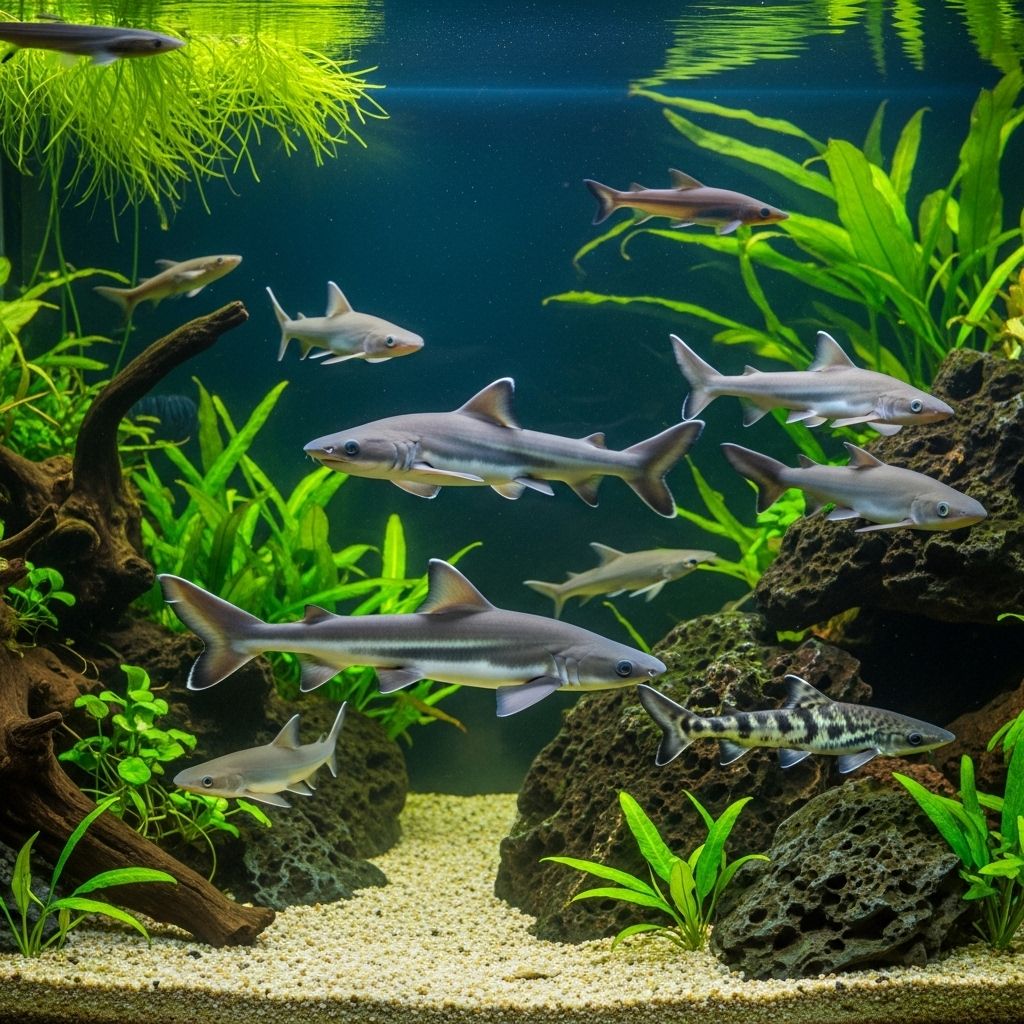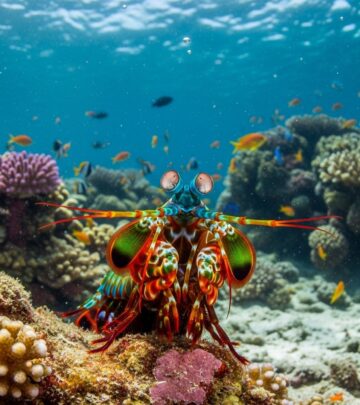Freshwater Aquarium Sharks: 9 Best Species For Your Home Tank
A comprehensive guide to the top freshwater sharks for home aquariums, including species profiles, care tips, and essential tank requirements.

Image: HearthJunction Design Team
Top 9 Freshwater Sharks for Aquariums
Freshwater sharks are popular in the aquarium hobby, not because they are true sharks, but because of their distinctive, sleek, and often intimidating appearance. Most so-called “freshwater sharks” are species of cyprinids, catfish, or minnows, noted for their torpedo-shaped bodies and dramatic finnage. This comprehensive guide explores the most popular freshwater shark species suitable for home aquariums, their care requirements, and tips for choosing the right one for your tank.
Note: While these fish are often called “sharks,” they are not related to the ocean-dwelling predators. The name refers purely to their body shape and swimming style.
What Are Freshwater Sharks?
Freshwater sharks are a group of fish species that resemble sharks in body shape and movement but are not true sharks. They typically belong to families such as Cyprinidae, Pangasiidae, or Balitoridae. These fish are known for their striking appearance, active behavior, and sometimes bold personalities. They require specific tank setups to thrive and often grow much larger than beginners expect.
- Sleek, streamlined bodies similar to marine sharks
- Active swimmers, requiring ample tank space
- Varied temperaments, from peaceful to territorial
Best Freshwater Sharks for Aquarium Hobbyists
Below are detailed profiles of the nine most commonly kept freshwater sharks, with care advice and compatibility tips for each species.
1. Bala Shark (Balantiocheilos melanopterus)
Bala sharks are among the most popular and visually striking freshwater sharks. Their silvery bodies and bold, black-edged fins give them an unmistakably “shark-like” look. Despite the name, bala sharks are peaceful, schooling fish and can make great additions to large, community tanks.
- Size: Up to 13 inches (33 cm)
- Minimum Tank Size: 125 gallons per fish, often kept in groups of 3-5
- Temperament: Peaceful, prefers company of its own kind
- Care Level: Intermediate
- Water Temperature: 72-82°F (22-28°C)
- pH: 6.0–8.0
- Notes: Sensitive to ammonia; requires excellent filtration and regular water changes
2. Silver Apollo Shark (Luciosoma setigerum)
With a shimmering, silvery-gold body and a faint dark stripe, Silver Apollo sharks are fast-moving and thrive in small schools. Their impressive size and agility make them a dynamic choice, but they require a spacious tank with plenty of open swimming room.
- Size: Up to 10 inches (25 cm)
- Minimum Tank Size: 125 gallons for a group of 5–6
- Temperament: Peaceful, active, best kept in groups
- Care Level: Intermediate
3. Roseline Shark (Sahyadria denisonii), aka Denison Barb
Roseline sharks are ideal for beginners due to their manageable size, peaceful demeanor, and vibrant coloring. They bring energy and color to aquariums and do well in schools.
- Size: Up to 6 inches (15 cm)
- Minimum Tank Size: 55 gallons for a school
- Temperament: Peaceful, active swimmer
- Care Level: Easy
- Best For: First-time freshwater shark enthusiasts
4. Red Tail Shark (Epalzeorhynchos bicolor)
Red Tail Sharks are striking with jet black bodies and a vivid red caudal fin. They are known for being territorial and tend to establish claims over caves or decorations. Best kept singly unless in a very large tank with plenty of hiding spots.
- Size: Up to 6 inches (15 cm)
- Minimum Tank Size: 55 gallons
- Temperament: Territorial, semi-aggressive
- Care Level: Intermediate
- Notes: Provide caves and plenty of cover
5. Rainbow Shark (Epalzeorhynchos frenatum)
Rainbow sharks have a similar build and temperament to Red Tail Sharks but boast a dark body with red or orange fins throughout. Territorial and best kept alone unless in a large tank with robust filtration and many hiding places.
- Size: Up to 6 inches (15 cm)
- Minimum Tank Size: 55 gallons
- Temperament: Territorial, semi-aggressive
- Care Level: Intermediate
6. Colombian Shark (Ariopsis seemanni)
This species, sometimes called the High-fin or Silver Catfish, is often sold as a freshwater fish but prefers brackish water as it matures. Growing to over 12 inches, Colombian Sharks are powerful swimmers requiring lots of room and a secure lid.
- Size: Up to 20 inches (50 cm)
- Minimum Tank Size: 150 gallons
- Temperament: Peaceful, can be kept in groups
- Notes: Needs brackish water as adult; escape artist
7. Black Shark (Labeo chrysophekadion)
Black Sharks are large, jet-black fish with an imposing presence. They are robust and active but can become aggressive, especially if kept in undersized tanks. Due to their potential size, they are best for very large aquariums and experienced keepers.
- Size: Up to 24 inches (60 cm)
- Minimum Tank Size: 200 gallons
- Temperament: Aggressive, territorial
- Care Level: Advanced
8. Iridescent Shark (Pangasianodon hypophthalmus)
Despite the popularity of Iridescent Sharks in pet stores, they are not suitable for most home aquariums due to their rapid growth and immense adult size. These gentle giants can surpass four feet in length and require public aquarium-sized tanks.
- Size: Up to 48 inches (120 cm) or more
- Minimum Tank Size: 500+ gallons (not recommended for home aquariums)
- Temperament: Peaceful, schooling fish
- Care Level: Advanced
9. Chinese Banded Shark (Myxocyprinus asiaticus)
Also known as the Freshwater Batfish, this species shows dramatic banding and a unique humped back. Juveniles are attractive and manageable, but adults can reach up to 36 inches, making them unsuitable for most home tanks.
- Size: Up to 36 inches (90 cm)
- Minimum Tank Size: 300+ gallons
- Water Temperature: 60°F and above
- Notes: Long-lived, needs very large aquarium or outdoor pond
Key Tank Requirements for Freshwater Sharks
Each species has its own optimal setup, but most freshwater sharks share common needs for clean water, swimming space, and secure covers.
- Tank Size: Review each species’ needs above; larger is almost always better
- Water Quality: Stable, clean water; avoid abrupt pH or temperature swings
- Filtration: High-capacity filter essential due to size and waste production
- Décor: Include caves and hiding spots for territorial species; open areas for schooling sharks
- Lid: Most freshwater sharks are strong jumpers—always use a secure cover
- Water Parameters:
- Temperature: 74–80°F (unless otherwise specified)
- pH: 6.8–8.0
- Hardness: 2–10° dKH (35–175 ppm)
- Salt: Some species (e.g., Colombian Shark) benefit from the addition of aquarium salt; check compatibility first
Freshwater Shark Compatibility and Community Tanks
Compatibility varies significantly between species. Some freshwater sharks are peaceful and thrive in community setups, while others are highly territorial or aggressive. Always research each species and consider the following tips for success:
- Avoid mixing territorial sharks (e.g., Red Tail and Rainbow) in the same tank
- Provide visual barriers and plenty of space if keeping semi-aggressive species
- Peaceful, schooling sharks (e.g., Bala, Roseline, Silver Apollo) often do best with their own kind
- Monitor for aggression, especially as individuals mature
Feeding Freshwater Sharks
Most freshwater sharks are omnivorous and benefit from a varied diet:
- High-quality sinking pellets or wafers as a staple
- Supplement with bloodworms, brine shrimp, or tubifex worms (live or frozen)
- Vegetable matter such as blanched spinach, zucchini, or algae wafers
- Some may nibble on live plants—consider robust species like Amazon swords
Common Challenges and Mistakes
- Underestimating Size: Many sharks outgrow typical home tanks very quickly
- Poor Water Quality: Sensitive to ammonia and nitrate spikes; frequent water changes are a must
- Incompatible Tankmates: Mixing aggressive sharks or placing them with small, slow fish can result in stress or injury
- Jumping: Always secure the aquarium lid
Breeding Freshwater Sharks
Breeding most freshwater sharks in home aquariums is extremely difficult and rarely achieved without the use of hormones or commercial-scale operations. Species like the Bala Shark and Red Tail Shark rarely, if ever, breed successfully in captivity without special intervention.
Table: Freshwater Shark Species Comparison
| Species | Max Size | Tank Size | Temperament | Ease of Care | Recommended For |
|---|---|---|---|---|---|
| Bala Shark | 13″ | 125 gal | Peaceful | Intermediate | Large community tanks |
| Silver Apollo Shark | 10″ | 125 gal (group) | Peaceful | Intermediate | Active, large setups |
| Roseline Shark | 6″ | 55 gal | Peaceful | Easy | Beginners |
| Red Tail Shark | 6″ | 55 gal | Territorial | Intermediate | Experienced keepers |
| Rainbow Shark | 6″ | 55 gal | Territorial | Intermediate | Experienced keepers |
| Colombian Shark | 20″ | 150 gal | Peaceful | Advanced | Very large/brackish tanks |
| Black Shark | 24″ | 200 gal | Aggressive | Advanced | Specialty setups |
| Iridescent Shark | 48″+ | 500+ gal | Peaceful | Advanced | Public aquariums |
| Chinese Banded Shark | 36″ | 300+ gal | Peaceful | Advanced | Ponds/very large tanks |
FAQs About Freshwater Sharks in Aquariums
Are freshwater sharks real sharks?
No. The freshwater “sharks” kept in aquariums are not true sharks (order Selachimorpha), but rather fish that resemble sharks in body shape and swimming behavior.
Which freshwater shark is best for beginners?
The Roseline Shark is generally recommended for beginners due to its manageable size, peaceful nature, and ease of care.
Can freshwater sharks be kept together?
Some peaceful species like Bala Sharks or Silver Apollo Sharks can be kept together in appropriate schools, but highly territorial sharks like Red Tail and Rainbow should usually be kept singly.
How big do freshwater sharks get?
Sizes vary by species, ranging from 6 inches in Roseline and Red Tail Sharks to over 4 feet in Iridescent Sharks. Always review adult sizes before purchasing.
Can I keep freshwater sharks in planted tanks?
Many species do well in planted tanks, but some (like the Red Tail Shark) may nibble on or uproot plants. Choose hardy species and ensure plenty of cover.
Conclusion
Freshwater sharks can be fascinating, rewarding additions to the home aquarium when their needs are properly met. Before choosing a species, research its adult size, temperament, and tank requirements. Always prioritize the well-being of your aquatic pets by providing a spacious, well-maintained environment with compatible tankmates. With the right preparation, these stunning fish can become the stars of your aquatic setup!
References
- https://www.petmd.com/fish/top-9-freshwater-sharks-aquariums
- https://www.petmd.com/fish
- https://www.aqueon.com/resources/care-guides/sharks-freshwater
- https://www.tfhmagazine.com/articles/freshwater/into-the-deep-a-survey-of-freshwater-sharks-full-article
- https://www.aquariumcoop.com/blogs/aquarium/freshwater-sharks
Read full bio of Shinta












